The E-1 visa, also known as the treaty trader visa or trade visa, is a subcategory of the e-visa and is thus one of the work visas the USA. It allows key individuals in companies, such as managers, to stay in the United States to trade in goods, technology, or services. Since applying for more time and cost saving than, for example, an L visa, the E-1 visa is an alternative worth considering. We will be happy to help you with the application process.
Visa category: work visa
Target group: Entrepreneurs (and their employees) planning to set up trade agreements in the USA
Validity: 5 years
Lengsth of stay: up to 2 years per entry
Characteristics: based on trade
The Treaty Trader Visa is a work visa and is available to companies who substantial trade between the contracting country and the USA. It is company-linked and allows foreign employees to work for a U.S. company.
Once a company has successfully applied for an E-1 visa for an employee, it is deemed to have E-registered and from now on can hire additional employees send them simplified to the USA via this visa category or deploy them there. It does not matter whether employees are to start a long-term assignment or whether they have to travel to the USA for multiple business trips.
This nonimmigrant visa is based on bilateral treaties between the United States and countries trading with it (Treaty Country). Currently, there are approximately 50 nations that maintain such relations with the United States. Germany, Austria and Switzerland are also among them.
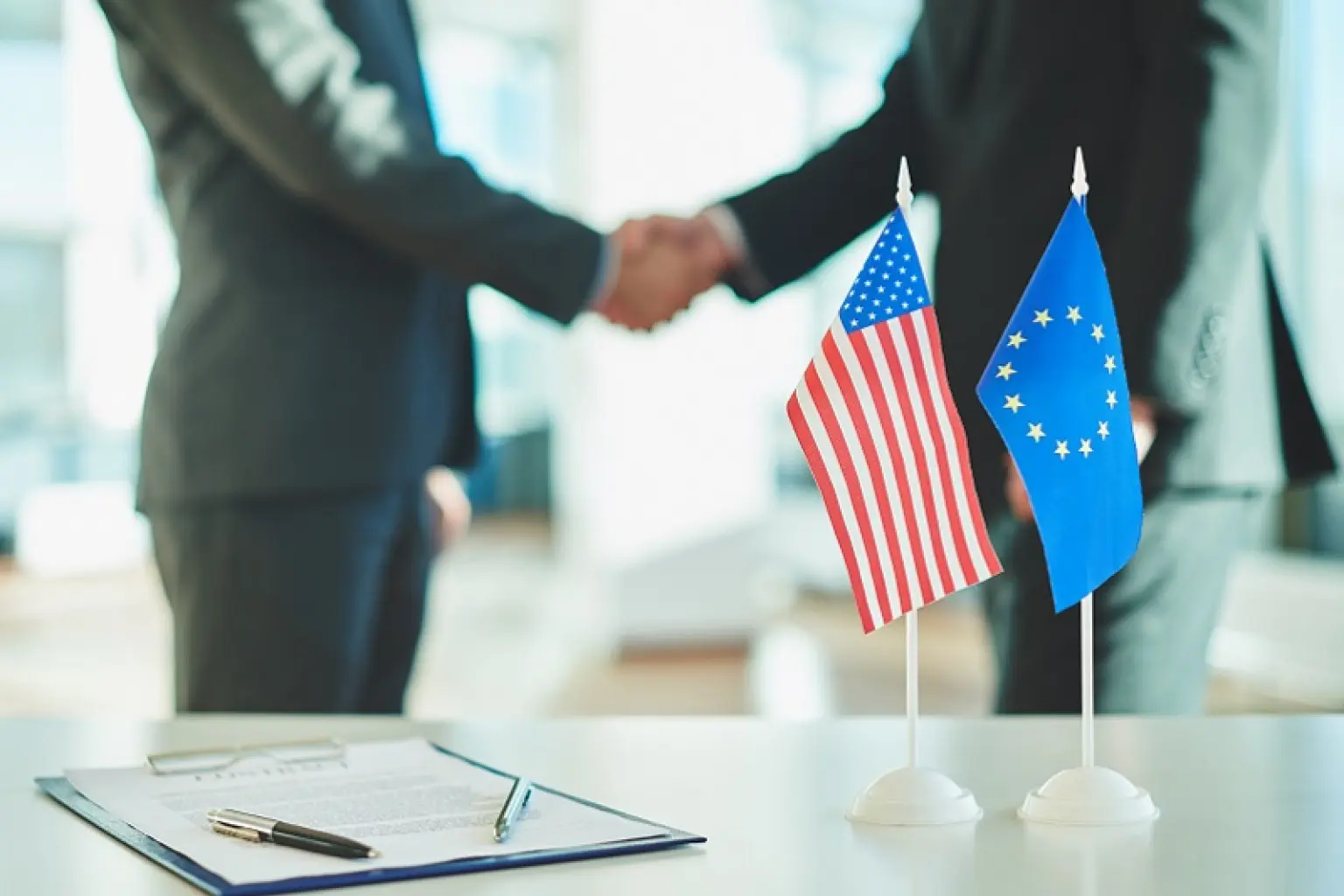
Both the applicant company and the employees must meet certain requirements to be eligible for this US work visa.
Minimum period of employment
There is no minimum employment period for employees within the group of companies, unlike the L visa. As a result, new personnel can also be posted or deployed in the USA via the E-1 status. However, it must also be proven that new employees who are not managers or directors have the necessary specialised knowledge.
In order for employees to be eligible for the US trade visa, the company must meet the following eligibility requirements:
Employees who are to receive the US trade visa must also meet certain requirements:

The period of validity of an e-visa depends on the nationality of the applicant. Depending on the nationality, the so-called reciprocity schedule decided how long the visa will be valid. For example, German citizens usually receive a five-year E-1 visa.
But the issuance of a one-year or two-year E-1 visa is also possible, especially if it is a smaller company that can only demonstrate a small volume of trade. In addition, for smaller companies, the issuance of E-1 visas may be based on the remaining registration period. However, for medium to large companies with a high number of US personnel, the E-1 visas are most often issued on 5 years, no matter how long the E registration is still valid.
Upon entry into the US, border officers decide how long E-1 visa holders may stay in the United States. The E-1 visa holder's authorized length of stay is recorded on form I-94. Generally, he or she will be granted a two-year stay authorization for the first and all subsequent entries. The extension of the stay in the US is unlimited as long as the registration of the US company is available, the employee has a valid visa and he or she can prove a (for instance German or US) employment contract or assignment contract within the group of companies.
In contrast to many other US visa categories, extensions of the E-1 visa for a further five years are theoretically possible indefinitely as long as the company successfully exists in the USA and all other access requirements for E-registration are still met.
The extension of the stay in the USA is possible indefinitely as long as the US company is registered, the employees have a valid visa and can provide proof of a (German or American) employment contract or assignment contract within the group of companies.
Incidentally, if the company has more than 25 permanent employees, the registration can be extended using a simplified procedure. Otherwise, the initial registration process applies again for additional employees.
It should be noted that the remaining period of validity of the old visa is not transferred to the new visa. In addition, an earlier visa application does not guarantee a new visa approval. All application documents must be submitted again in full to the US consulate/US embassy.
Therefore, it is advisable to prepare the application carefully and ensure that all required documents are complete in order to minimize potential delays or rejections during the extension process or reapplication. Processing times can vary considerably depending on the relevant US consulate or embassy, so sufficient advance notice is recommended.
The application fee for the E-1 visa is 283.50 € (315 $) per applicant. This general fee, which is charged by the US consulates or the US embassy is binding for all applicants and cannot be refunded or transferred to other persons.
The processing fee can be paid either online by bank transfer, online payment by debit card or in cash at a bank.
Normally, this fee for making an appointment is valid for up to one year from the date of payment.
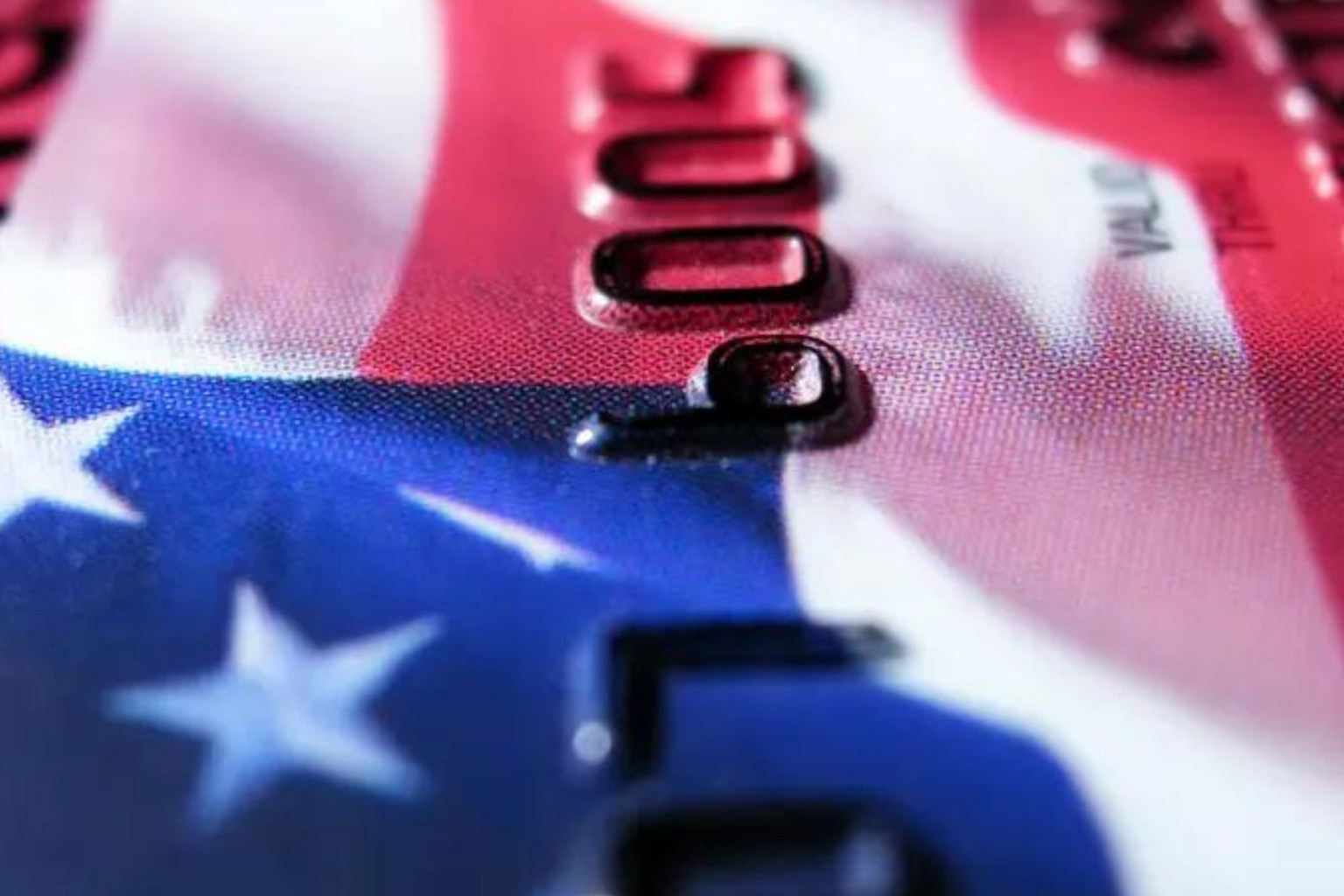
In addition, the following costs may apply for certain E-1 applicants:
Further information on the various visa fees, any costs that may be incurred and the current payment methods can be found on our fees page.
Initial company registration applications are submitted to the relevant US Consulate General in the contracting country. For German companies, only the US Consulate General in Frankfurt am Main is responsible.
The following steps must be followed when applying for a trade visa:
On the basis of this registration, companies can then - in a very simplified procedure - send additional nationals of the contracting country to the US location or deploy them there. Additional employees can skip the first part of the application process and bring all documents and forms directly to the personal interview at the US consulate.
Compared to other work visa categories, such as L-1 or H-1Bthe E-1 visa is relatively time and cost efficient.
The US consulate can take around two to three months for initial registrations. In addition, there is the waiting time until the interview date, which depends on the respective consulate or the season, among other things. In this case, the application should therefore be submitted at least six months before the planned work assignment.
As soon as the company is already "E-registered", i.e. has already successfully applied for at least one E-1 visa for an employee, the previous check can be skipped. In this case, the visa is applied for directly at the personal interview appointment.
Approximately one week after the successful interview at the consulate, employees will receive their passport and visa by post.
Applicants should follow the steps below to apply for an E-1 visa for the USA:
The first step in applying for an E-1 visa for the USA is to complete the electronic visa application form DS-160 on the website of the U.S. Department of State.
The digital application form requires detailed information about the applicant and the planned stay in the United States. It is therefore advisable to have the following documents ready when completing the online DS-160 form:
You can check the status of your visa application online just a few days after submitting your DS-160 form.
Did you know that the professional processing and submission of your DS-160 form is part of our service?
Create your own visa profile on the website of the visa information service through which your visa applications will be processed in the future.
Here you can also pay the visa processing fee directly and make an appointment for the visa interview.
When you commission our US Visa Service, we create the required online profile, pay the consular visa application fee and arrange the appointment for the personal interview with the US consular officers.
Show up personally on the day of the interview in the US consulate or at the US embassy. Your documents will be checked there and you will be interviewed by the consular officers.
The following documents must be prepared and brought along for the appointment at the US Consulate or US Embassy:
Be prepared to answer questions about your visa application, your planned stay in the U.S. and other relevant topics.
As a rule, E-1 visa applicants are informed at the end of their visit to the US consulate or embassy whether or not their visa application will be approved.
Our visa consultants will prepare you perfectly for this important appointment and provide you with the necessary documents to ensure that your visa interview runs as smoothly as possible.
If your visa application is approved, you will receive your passport with the E-1 visa returned by post or can arrange a pick-up appointment.
The E-1 visa contains a variety of information that identifies the visa holder and defines his or her rights and restrictions while in the United States.
It is crucial that you review this information carefully and ensure that it meets the requirements of your planned stay in the USA.
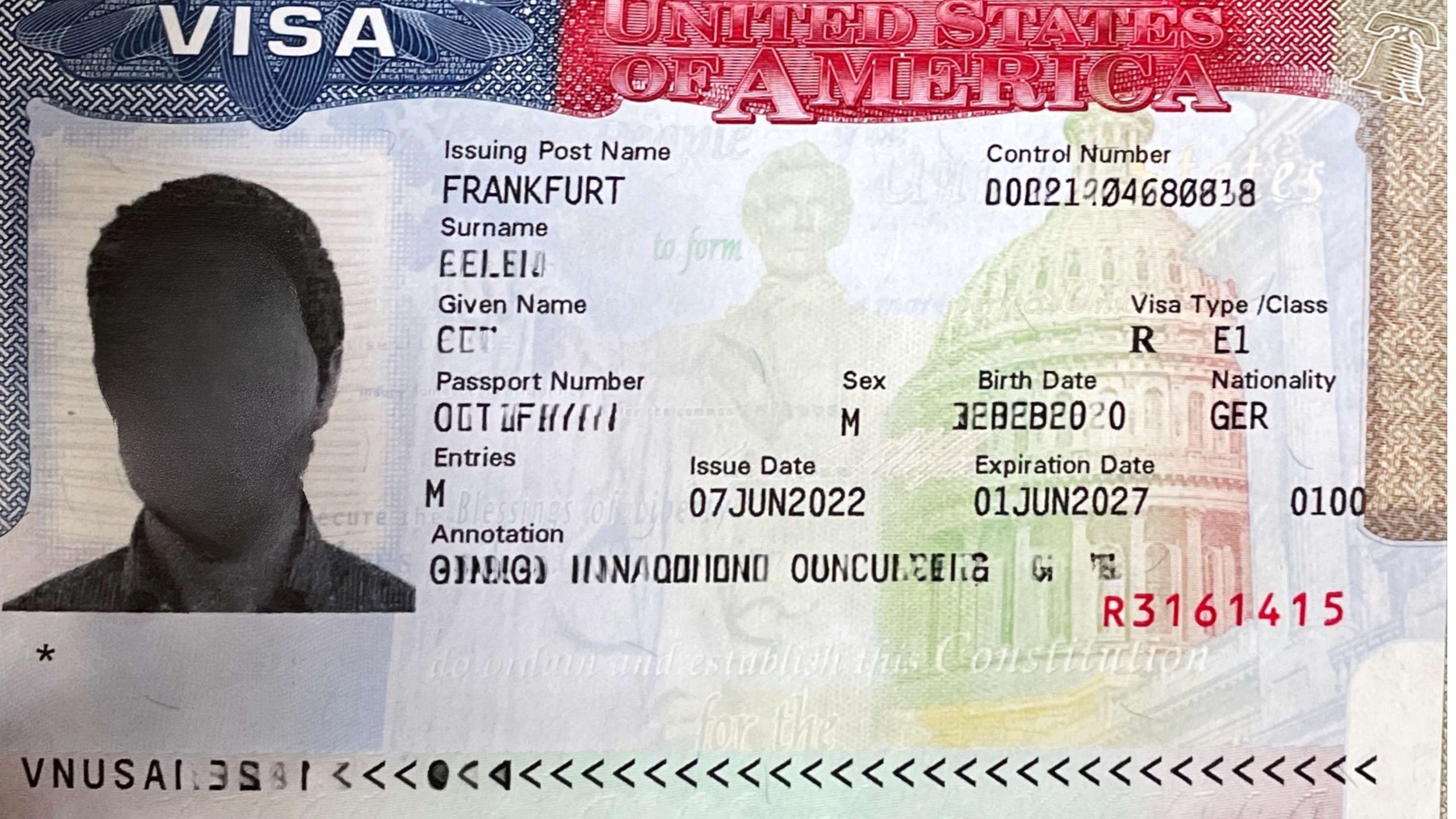
Here are some of the dates and information that can be found on a US visa:
The issuing of visas for the United States of America is the responsibility of the US consulates and embassies.
As a rule, the decision committee of the US consulates will decide on the day of the visa interview whether or not to issue a visa for the USA. Applicants for an e-visa usually receive a decision on visa issuance during their interview appointment.
You can check the status of your US visa application check online.
Your E-1 visa was granted verbally by the US officials and is now being finalized.
After the E-1 visa has been printed or issued in the passport, the passport with the corresponding US visa will be sent by post.
In some cases, US consular officers decide not to approve the e-visa immediately and issue a visa refusal in accordance with Section 221(g) of the Immigration and Nationality Act (INA). The consequence of this is so-called administrative processing. The US visa application therefore requires a further security check and is subject to additional processing steps. Additional documents or information may be required from you.
If the US officials conclude that you do not qualify for the E-1 category, your visa to the US will be denied. The denial does not have to be justified, but applicants who are denied a visa are usually given further instructions on the day of the interview appointment or sent a denial letter after a certain processing time.
The reasons vary greatly depending on the visa category and applicant (e.g. assumption of an intention to immigrate, suspicion of illegal employment, incorrect application documentation).
Often, a visa application is rejected because the necessary visa requirements are not met. For example, applicants may not meet all the requirements of the visa category applied for, such as a lack of ties to the home country, a lack of financial resources or difficulties in proving the legality of a US company and its ability to properly hire and pay employees. In addition, discrepancies may arise during the visa interview, especially if the visa category applied for does not match the purpose of the entry, for example if an immigration intention or illegal work is suspected.
Furthermore, errors in the visa application or incomplete documentation can lead to a rejection. This includes incomplete documents, incorrect information in the DS-160 visa application form or inadequate preparation of the E-1 visa application.
The applicant's personal circumstances also play a role and are often frequent reasons for rejection. These can include previous convictions, a terrorist background, infectious diseases, immigration offenses such as illegal residence or illegal work in the USA, as well as conspicuous behavior during previous entries.
The consequences for the applicant in the event of a refused E-1 visa depend on the reasons for the refusal.
A refusal of a category E visa usually means that visa-free entry with ESTA is no longer possible. This is due to the fact that the ESTA application asks whether a visa has been refused. If this question is answered with "yes", the ESTA application is usually rejected.
If the E-1 visa is rejected, the applicant will not be able to travel to the USA for the planned purpose (e.g. vacation, work assignment, study, au pair).
In some cases, the US authorities may even impose an entry ban for the USA.
Even if the US authorities do not have to justify the refusal, you can politely ask for the reason for the refusal at the interview appointment at the US consulate. This information will help you if you wish to reapply for the E-1 visa.
Your E-1 visa application should be prepared carefully and conclusively in the second attempt at the latest. This includes choosing the right category, completing the DS-160 online form correctly and to collect meaningful evidence.
We advise you on the choice of the appropriate visa category and take over the complete processing for you or your company.
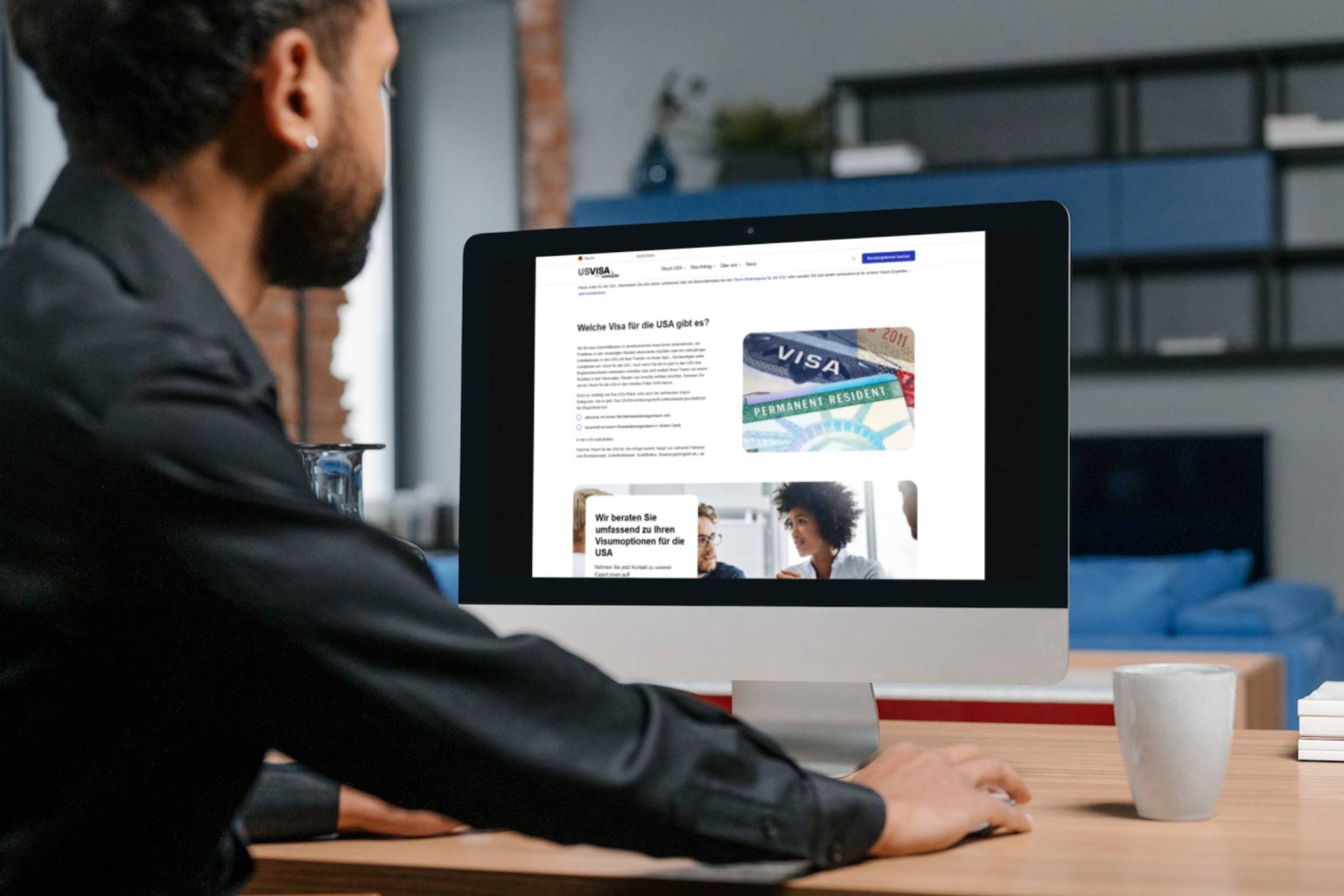
Many applicants mistakenly assume that they will automatically be allowed to enter the United States with an approved US visa. However, an e-visa entered in the passport does not automatically guarantee entry into the USA. Legally speaking, a US visa is not a residence permit, so even with an approved visa, there is no certainty of entry into the United States. A valid US visa only entitles the holder to apply for entry into the USA at the border crossing, for example at the airport.
The final decision on entry is normally made by the border officials who check the visa when foreign nationals enter the USA. U.S. Customs and Border Protection officials make the final decision on whether entry is allowed and, if so, for how long. It is therefore possible that entry may be denied.
After obtaining an entry permit, it is advisable, to check your I-94 online or check the entry stamp in your passport to see how long you are legally permitted to stay in the USA.
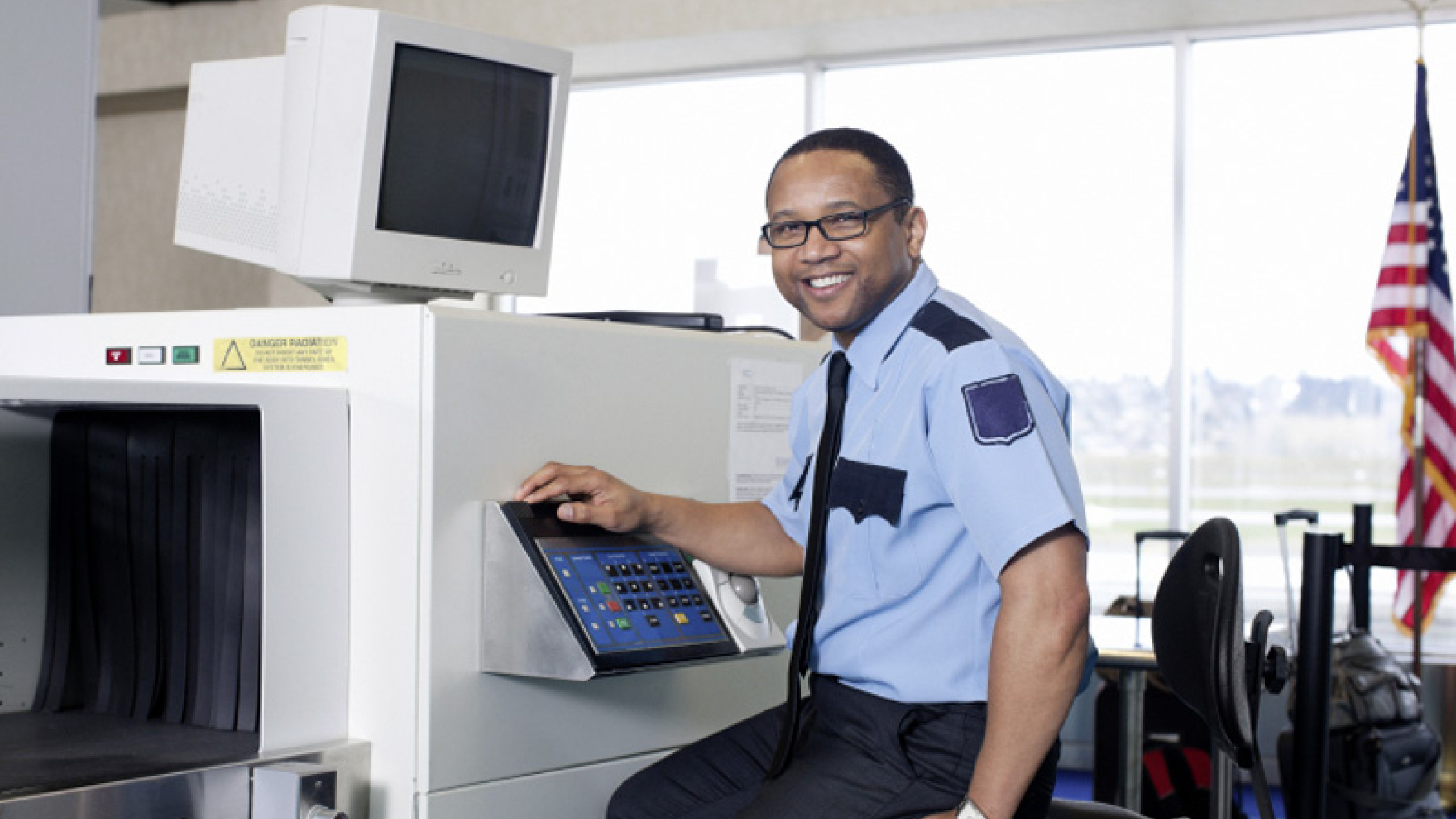
Incidentally, Global Entry enables certain travelers who have been biometrically registered and security-checked to complete their entry formalities independently and automatically at almost all major US airports. This allows foreign travelers to avoid long waiting times and enter the USA more quickly.
The Treaty Trader Visa offers a variety of benefits for both companies and employees who are to receive the visa.
Particularly in comparison to the expensive L-visa procedure, E-visas therefore always represent a worth checking alternative!
The nationality restriction may be a disadvantage for certain applicants:
The nationality of the employees must correspond to the nationality of the company. This means, for example, that German companies can only issue E-1 visas to German nationals.
Spouses and unmarried children up to the age of 21 have the option of applying for a derivative status, which allows them to obtain an E-1 visa with an additional endorsement.
Spouses who hold a derivative E-1 visa can apply for a General Work Authorization (Employment Authorization Document, EAD), either with the U.S. Citizenship and Immigration Services (USCIS) or upon entry by Border Patrol agents. This means that they are not tied to a specific office or the company of the main applicant and can work in the USA independently of their spouse.
This work permit is initially issued for two years and can be extended for a further two years, up to the maximum duration of stay of the main applicant.
Children of E-1 holders have the right to attend educational institutions (schools/universities) but are not allowed to engage in paid work. Once they reach the age of 21, they must either change their non-immigrant status or leave the country.

Global Entry can be used with almost all US visas and even ESTA authorization. If you have an E-1 visa, you can apply for Global Entry membership and enter the United States more quickly.
Many companies ask themselves what happens to the company-bound E-1 work visa when visa holders no longer work for the company.
If the visa holder is dismissed or resigns, the work visa for the USA automatically loses its validity. The derived visas of any accompanying family members also lose their validity upon termination of the employment relationship, as these are linked to the visa of the main applicant.
This means that former visa holders are no longer allowed to enter the country with their E-1 visa once their employment relationship has ended, even if the work visa is theoretically still valid. If affected visa holders wish to travel to the United States for tourism or business in the future, they must reapply for an ESTA authorization or a corresponding visa, depending on the purpose or depending on what activities are carried out there and for how long.
Practical tip: In order to avoid discrepancies or problems with subsequent entries after the visa has been terminated, it is advisable to inform the US consulate about the new work situation. For this purpose, it is sufficient if the responsible company representative (e.g. HR manager, supervisor, board member, etc.) sends an e-mail to the responsible consulate with the request to invalidate the visa of the former employee. If possible, a copy of the visa should be attached. The consulate will then make a corresponding note in the system so that the US officers at the US border are also aware of this.
In some cases, visa holders are even contacted directly by the US consulate with the request to send in the E-1 visa so that it can be invalidated. In other cases, the visa is simply invalidated by the border officer the next time you enter the US.
Our recommendation: Companies can protect themselves by sending a brief notification to the relevant US consulate and, above all, be sure that entry with the previously valid work visa is no longer possible. Don't take any risks and prevent possible abuse with the company-bound E-1 visa.
If the ownership structure of a company with a valid E-1 visa or E-1 registration changes, this has a direct impact on the validity of the E registration and all E visas based on it.
If the majority of your company, despite its existing E status, has since been transferred to US ownership, for example, you can no longer send employees on E status to the United States.
E-1 work visas automatically lose their validity. The derived visas of any accompanying family members also lose their validity due to the "loss" of the E-1 registration, as these are linked to the visa of the main applicant.
This means that visa holders are no longer allowed to enter the country with the visa, even if the work visa is theoretically still valid.
After a change in ownership, the company must check (or have checked) whether a new E registration can be applied for:
Only if the requirements continue to be met (e.g. new owners are also from an E contracting state) is it possible to continue the E status. Otherwise, other visa categories must be taken into account.
Wir und unsere Partner nutzen Cookies, um personenbezogene Daten wie z.B. Browsing-Daten zu speichern und abzurufen, um z.B. Inhalte und Werbung bereitzustellen und zu personalisieren sowie die Verwendung der Website zu analysieren und das Benutzererlebnis zu verbessern. Sie erfahren mehr über die Zwecke, für welche wir und unsere Partner Cookies einsetzen, wenn Sie unten auf den Button „Cookie Einstellungen“ klicken. Hier können sämtliche Einstellungen auch geändert werden. Nachträglich kann man jederzeit seine Cookie-Auswahl überdenken oder seine Einwilligung widerrufen, indem man auf den Link zu den Cookie-Einstellungen im Footer unserer Webseite klickt. Beachten Sie bitte, dass das Blockieren einiger Cookie-Typen unsere Möglichkeiten zur Bereitstellung von auf Ihre Interessen zugeschnittenen Inhalten haben kann oder einige Funktionen der Webseite nur eingeschränkt zur Verfügung stehen.
Durch klicken auf “Alle Cookies akzeptieren” stimmen Sie unserer Nutzung und der Weitergabe Ihrer Daten an unsere Partner zu.